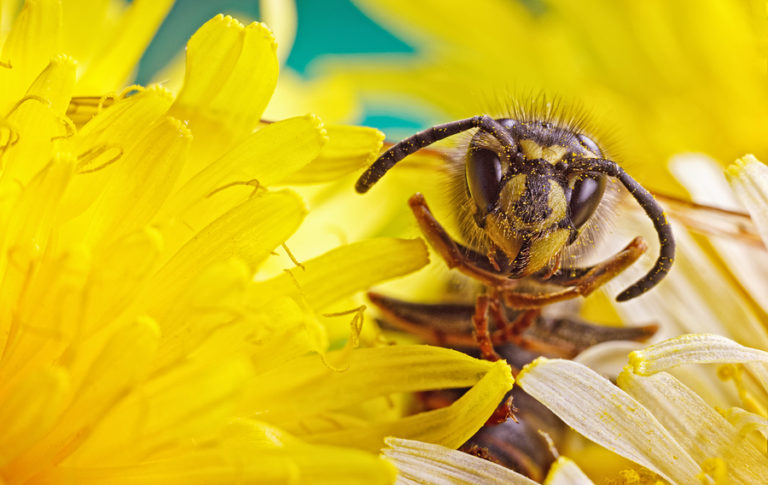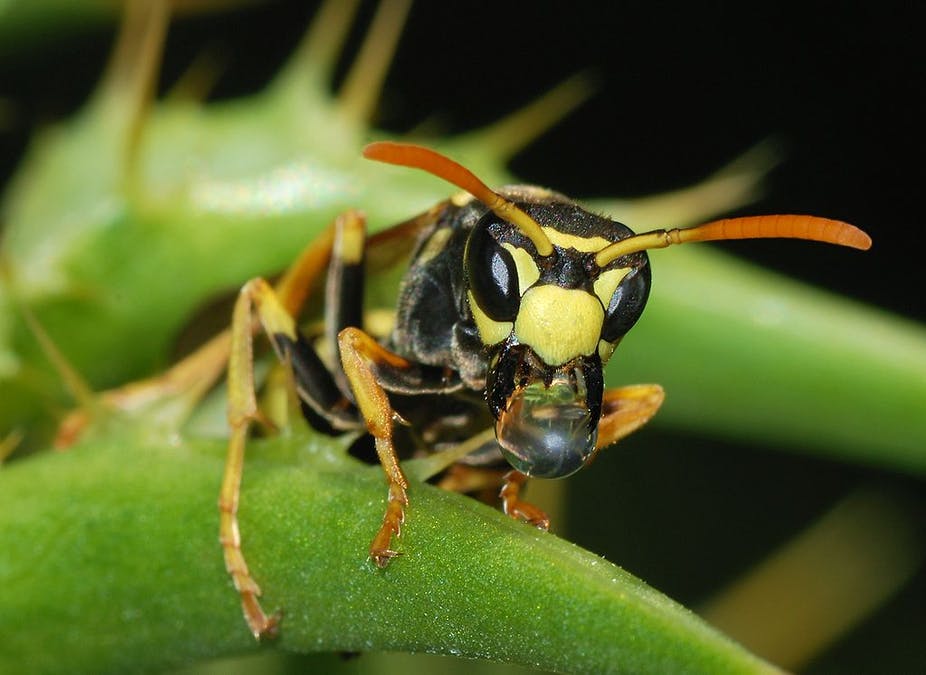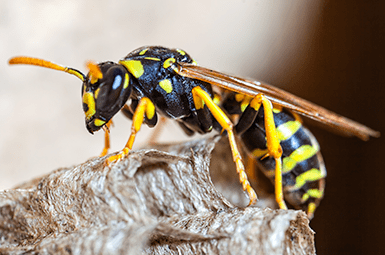Why Wasps Are Attracted to Your Home
Have you ever wondered why there are wasp nests near your home when it warms up outside? It’s worth knowing what these annoying pests look for when choosing a location for their nests. We’ll also give you a few tips on how to dissuade wasps from moving in around your home.
What a Wasp Thinks About When Searching for a Home
Humans look for a home that provides shelter from the elements and enough space to live comfortably. Unfortunately, wasps aren’t as selective. They’ll build their nests just about anywhere, so long as they have a sturdy, horizontal base to hang from.
Eaves, Ceilings and Overhangs
The favored nesting spots for wasps are eaves, porch ceilings and overhangs. They often choose a corner spot where the nest will be more protected
Supply of Weathered Wood
Paper wasps, a very common species, get their names from the nests they construct. They build nests using wood fiber, therefore they need a construction resource near the nest. The queen wasp scrapes wood fiber from wood materials, and chews it to mix the fiber with her saliva, creating a paper pulp. She then spits it out at the desired build site to shape and create the nest. Gross, but very efficient for building.
Insect Food Supply
The one good quality wasps have is that they control the insect population by eating other bugs – placing them in the category of beneficial yard pests. The bad news is that if they decide your home is a good nesting location, that probably means there’s an ample food supply nearby
Access to Indoor Shelter
You’ll be happy to know if wasps made a nest on your property last year they won’t come back to it. Wasps abandon their nests in fall and let Mother Nature take its course to decompose it. The downside is that the queen seeks shelter indoors to survive the winter. If she is successful she can start the process all over again come spring.

Camping News
Maybe you hate midges and are irritated by flies. But no insect creates as much fear in the Danish late summer as the flying devils with black and yellow stripes. Stinging wasps are not popular, but they are very interesting. Here’s why.
Bzzz. First you hear the deep hum, and then you see the swaying flight and the ominous black and yellow stripes. You know that from now on there will be no peace for your meal. But actually what are wasps? Are they just striped evil on wings, or do they actually have a justified place among Danish fauna?
Wasps can be divided into many species, but those we typically deal with are the common wasp (Paravespula vulgaris) – and in some cases the hornet (Vespa crabro).
Wasp nests fall to pieces in the late summer. So the wasps you meet in September and possibly October are particularly bad-tempered. They are just waiting for certain death and like drug addicts they are always in search of their favourite drug: Sugar. Therefore they no longer take care of the most important tasks in the wasp nest. This is the time that they are particularly interested in the food you are eating and they can be a nuisance at any barbecue or cake table
Unlike bees and bumblebees, which lose their sting and die when they sting, the wasp’s sting is smooth and has no barbs. And so it can easily sting several times.

Wasps deserve to be loved
Recently a newspaper asked its readers to propose species that were, ecologically speaking, “useless”, such that their loss would not have any great knock-on effect on other species or biological cycles. And what did they choose to illustrate this question with? A wasp – which, along with stinging nettles and dog dirt are pretty much the only appreciable natural hazards in the British Isles.
Like many other species of the order Hymenoptera, these insects have modified ovipositors that no longer lay eggs but instead sting. While bees either make honey or look fluffy and bumbling, these black and yellow wasps seem to do nothing but ruin whatever weather passes for a British summer by pestering picnics and dive-bombing barbeques.
Getting stung by a wasp is not a great deal of fun. For an unlucky few it can even be life-threatening if they experience an extreme immune system reaction to the venom and enter anaphylactic shock. In some regions some wasps are considered invasive species, which have in a relatively short period of time wrought havoc on native ecosystems.
But I want to consider our attitudes to these species in their native habitats. I want us, in short, to love wasps – for two reasons.
First, wasps are not useless but in fact very important elements in complex ecosystems. Adult wasps feed on nectar and sweet fruit (and possibly your unattended soft drink or beer as they will be attracted to its strong smell). By feeding on nectar, wasps are pollinating species. But it is the feeding requirements of their larvae that produce arguably more important ecological effects as their larvae only eat solid food. Consequently, a great deal of an adult wasp’s time is spent searching for species that we consider pests: aphids and caterpillars that eat the plants that we want to eat, or like to admire.

Why Do Wasps Choose My Home?
When paper wasp nests appear on your home year after year, it can feel like those wasps are targeting you and only you but you can take some solace in the fact that your home is probably not much more attractive to wasps than your neighbor’s is. Let’s take a quick look at some things that lure wasps in and see if there is anything you can do about them.
Wasp Attractants
Paper wasps prefer to live on a home that has more food options available. In fall, these stinging pests prefer protein. They get it from eating bugs. The more bugs you have in your yard, the more likely you are to have a wasp nest develop. Therefore, the first line of defense against wasps is a good pest control plan in general.
All pests need a drink, and wasps are no exception. If you have moisture conditions near your foundation, wasps will take notice. You can prevent moisture problems by fixing any leaking pipes, spigots, or hoses that are near your home. Trim bushes and trees to allow the sun to dry up rainwater. And loosen compacted soil that allows rainwater to pool.
Wasp Control
When it comes to controlling wasps, there isn’t a lot you can do to make your home less attractive, so one option is to remove nests when they start to develop or use pesticides to get rid of a fully developed nest. But the use of insecticides can be more harmful than having wasps around. It is best to have a pest control technician deal with wasps as part of an ongoing pest control service plan.
At Adams Exterminating Company, wasp and hornet control is just one of the services we provide in our year-round pest control packages. Request a free home estimate and find out which package will work best for your home. Wasps can be irritating pests to have around, but they are not the worst pests to have around. Get essential protection from pest threats with residential pest control from Adams

How Do Wasps Build Their Nests?
have you ever been playing outside when you hear a tell-tale buzzing sound? From experience, you know that you don’t want to get stung by any flying insects. You’ve been stung before and you know how painful it can be
You look up and you see a familiar sight attached to the underside of the eaves of your house. It looks a bit like a paper honeycomb, and it’s the center of attraction for a swarming group of flying insects. What is it? A wasp nest!
There are three main types of wasps you’re likely to run into from time to time: paper wasps, yellowjackets, and hornets. They are all similar in that they make paper nests. However, they differ in the size, shape, and location of their nests.
Paper wasps, for example, tend to build small, umbrella-shaped nests under eaves and overhangs. Hornets build large nests shaped like a football. You can often find them hanging from a high branch of a tree. Yellowjackets prefer to make their nests underground.
Where do wasps get the paper they use to build their nests? Do they steal paper from school children while they’re at recess? Not hardly! They actually make their own building materials by turning raw wood into paper pulp.